|
|
シンガポール 戦跡記念碑めぐり
|
Update |
|
1995年、第2次世界大戦終結50周年にあたるこの年、11基の戦跡記念碑がシンガポール国内に建立されました。 これらの記念碑は、第2次世界大戦時にシンガポールで起こった出来事を忘れず後世に伝えるために、「許そう、しかし忘れまい」のかけ声のもと、シンガポール政府(記念碑設立委員会)によって建てられました。 記念碑には、シンガポールの公用語である 英語,マレー語,中国語,タミール語 とともに、当時シンガポールを占領していた国の”日本語”の5カ国語によって説明文が刻まれています。 (日本占領時、シンガポールは「昭南島」とよばれていました。) 日本軍がシンガポールに上陸した海岸、シンガポール中心市街地侵攻時の戦場、憲兵隊支部が入っていたビル、「大検証(粛清)」検問場などシンガポール各地に記念碑が存在しています。 現在では多くの日本人観光客やビジネスマンが訪れるシンガポール。でもかつて日本がシンガポールで何をおこなったかを知る人は少ないのでは・・・。 過去の悲惨な歴史に目をそむけず、「事実」を知っておくこはとても大切だと思います。 記念碑にわざわざ”日本語”の碑文を刻んだのも、シンガポールの人たちのそのような思いが込められているからでしょう・・・。 前々からこれらの記念碑が気になっていましたが、シンガポールに自転車を持ち込む機会がありましたので、自転車でこれらの記念碑などを探してまわりました。 (1999年 8月)
※ 写真が多いのですべて表示されるまでに時間がかかるかも知れません。じっくりお待ちください…。(約 400 Kbytes) |
|
World War II Commernorative Signboard |
|
[Site_1] . SARIMBUN BEACH LANDING (サリンブン海岸上陸)
[Map] |
|
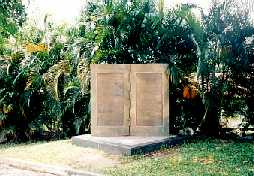 Site 1 の記念碑 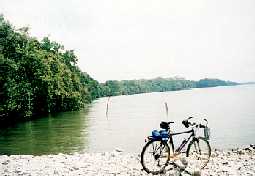 周辺の風景 |
On this mangrove-lined shoreline, Japanese forces launched their attack on Singapore. Protected by heavy artillery, fire, soldiers of the 5th and 18th Japanese Divisions crossed the Johore Straits in a fleet of small boats on the night of 8th February 1942. The first two waves of Japanese troops were repelled by Allied troops of the Australian 22nd Brigade. However, the third Japanese wave broke through the Australian defences to capture Tengah Airbase by the following morning. このマングローブの海岸線からシンガポール侵攻の火蓋が切っておとされた。 1942年2月8日夜、日本軍第5師団と第18師団は砲火の援護を受けつつ、渡航艇を並べてジョホール水道を渡った。 日本軍は2度上陸を試みたが、第22オーストラリア旅団によって撃退された。しかし3度目の攻撃で防御を突破し、翌9日朝までにテンガ空軍基地を攻落した。 |
|
[Site_2] . KRANJI BEACH BATTLE (クランジ海岸の戦い)
[Map] |
|
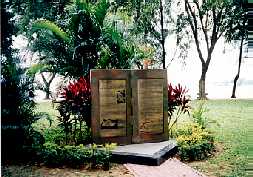 Site 2 の記念碑 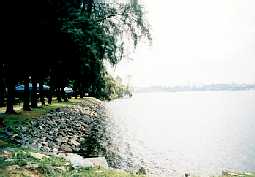 周辺の風景 |
On this shoreline between the Kranji River and the Causeway, troops of the 27th Australian Brigade and Singapore volunteers of Lieutenant-Colonel Dalley's DALFORCE scored a victory against the invading Japanese forces. On the morning of 10th February 1942,troops from the 4th Regiment of the Japanese Imperial Guards landed when the tide was low. They were stuck in the mud and were caught in oil slicks created by Allied troops releasing oil from the nearby Woodlands depot. The first waves of Japanese troops were burnt when Allied troops set fire to the oil. However, for fear of beging cut off by the Japanese landing from the west at Sarimbun and Jurong, the Australian troops and DALFORCE volunteers were ordered to with draw south, thus allowing the Japanese to land and consolidate their invasion of Singapore. 1942年2月10日朝、侵攻する日本軍が干潮に乗じてこの海岸線に上陸した。泥に足をとられた将兵らは、英軍が流した油の中で立ち往生した。第1陣は、英軍が油に放った火によって撃退された。 しかし、サリンブンとジュロンに上陸しつつある日本軍に退路を断たれる恐れから、英軍連合部隊に南方退却が命じられた。こうして日本軍は上陸を果たし、シンガポール侵攻の足場を固めた。 |
|
[Site_3] . THE JURONG-KRANJI DEFENCE LINE (ジュロン・クランジ防御線)
[Map] |
|
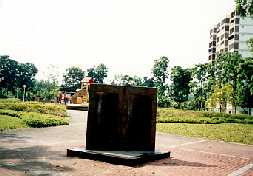 Site 3 の記念碑 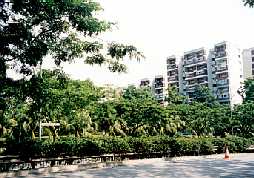 周辺の風景 |
The narrowridge connecting the sources of the Jurong and the Kranji Rivers was a natural defence line protecting the north-west approach to the city. The Allied troops were to defend this line strongly against the invading Japanese. However, Lieutenant-General Arthur Percival's secret orders to withdraw to the last defence line around the city, only if necessary, were misunderstood by the defending Allied troops. As a result, the 44th Indian Infantry Brigade, the 12th Indian Infantry Brigade and the 22nd Australian Brigade, reinforced after their withdrawal from Sarimbun Beach in the north-west, abandoned the Jurong-Kranji Line on 10th February 1942. This allowed the Japanese forces to Sweep through the line to attack Bukit Timah. シンガポール中心市街地への北西進入路を守るこの天然の防御線は、日本軍の侵攻に備える英軍連合部隊によって防備が固められているはずであった。 しかし、やむを得ない場合にのみ中心部外周の最終防御線まで後退せよとのパーシバル中尉の極秘指令を守備隊は誤って解釈した。このため、1942年2月10日、英軍連合部隊はジュロン・クランジ線から後退。日本軍はこの防御線を難なく通過し、ブキテマに進軍した。 |
|
[Site_4] . BATTLE FOR BUKIT TIMAH (ブキテマ攻防戦)
[Map] |
|
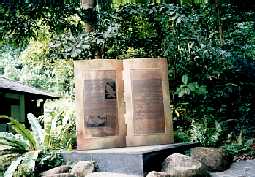 Site 4 の記念碑 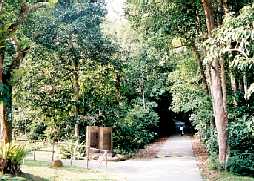 周辺の風景 |
Bukit Timah, which dominates the arterial Bukit Timah and Dunearn Roads leading to the city, was a strategically important point for both the Allied troops and the Japanese. On the night of 10th February 1942, the Japanese troops from the 5th and 18th Divisions, supported by armour, attacked troops of the 12th and 15th Indian Brigades, the 22nd Australian Brigade, The Special Reserve Battalion, Tomforce, Merrett's Force, the Argylls, Jind State Infantry and 'X' Battahion. The Allied forces had re-grouped to defend the critical junctions at Choa Chu Kang, Jurong and Clementi Roads leading to Bukit Timah Road. By dawn of 11th February 1942, the Japanese troops reported to their commander, Lieutenant-General Tomoyuki Yamashita that they had seized Bukit Timah. The road to the city was open. シンガポール中心市街地への幹線道路を見おろすブキテマ高地は、英軍と日本軍の双方にとって重要な戦略的要衝であった。 1942年2月10日夜、装甲部隊に支援された日本軍は、要衝防備のため再編成された英軍連合部隊に攻撃を加えた。 翌11日早朝までに日本軍はブキテマを攻略。中心市街地への道は無防備となった。 |
|
[Site_5] . BATLE FOR PASIR PANJANG (パシルパンジャン攻防戦)
[Map] |
|
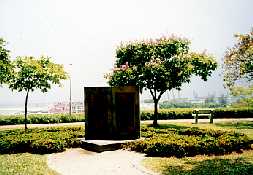 Site 5 の記念碑 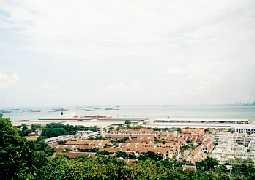 丘からの風景 |
One of the last battles for Singapore was fought on this hill which dominated the harbour and the British military depots in the Ayer Rajah area. On 13th February 1942 the Japanese 18th Division, with strong artillery and air support, attacked the 1st Malay Regiment, the British 2nd Loyals Regiment and the 44th Indian Brigade defending this locality. At the Battle, the men of the Malay Regiment, led by officers like 2nd Lieutenant Adnan of "C" Company, distinguished themselves. The "C" Company held its ground for 48 hours, and the last few survivors abandouned their posts only when the unit had almost been wiped out. シンガポールの最後の攻防戦のひとつがこの丘で繰り広げられた。 1942年2月13日、日本軍第18師団はここを守備する第1マレー連隊、英国第2砲兵連隊、第44インド人旅団を攻撃した。 マレー連隊は48時間にわたり陣地を死守した。最後の生き残りとなったマレー連隊C中隊の数人が持ち場を放棄したのは全滅の直前であった。 |
|
[Site_6] . LABRADOR BATTERY (ラブラドル砲台)
[Map] |
|
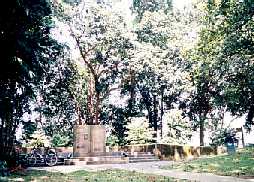 Site 6 の記念碑 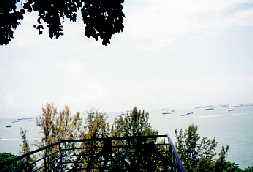 丘からの風景 |
In 1878 the British constructed an artillery fort on this ridge to defend the western entrance to Keppel Harbour. On the eve of World War II, Fort Pasir Panjang had two large six-inch guns. These 37-ton guns fired 102-lb shells over a range of 10 miles. The popular belief was that these guns were fixed to face only towards the sea. However, they could be, and were, turned around to fire on advancing Japanese troops. Fort Pasir Panjang on Labrador was one of a series of 11 coastal artilley forts built by the British in the 19th century to defend Singapore's waters. Other forts were on Sentosa, Pulau Brani, Fort Canning and Katong. These forts showed how the direction of potential threats to Singapore changed over the years. 1878年、英国はケッペル港の西口防備のため、この丘陵にパシルパンジャン砦を築いた。この砦はシンガポールの領海を防衛するため英国が19世紀に築いた海沿いの11の砦の1つである。 ラブラドル砲台には102ポンド弾を16キロの射程内に撃ち込める重量37トンの巨砲2門が据えられた。この巨砲はもっぱら海を睨んでいたが、旋回可能であり、迫る日本軍に砲火を浴びせるべく砲口は向きを転じた。 |
|
[Site_7] . SOOK CHING CENTRE (「大検証(粛清)」検問場)
[Map] |
|
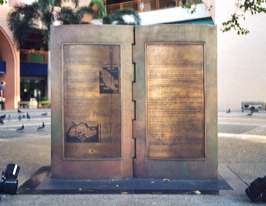 Site 7 の記念碑 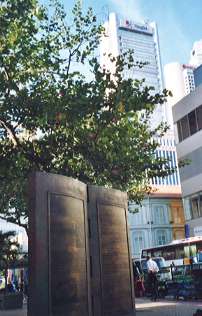 周辺の風景 |
This site was one of the temporary registration centres of the Japanese Military Police, the Kempeitai, for screening anti-Japanese Chinese. On 18th February 1942, three days after their capture of Singapore, the Kempeitai launched a month-long purge of anti-Japanese elemets in an operation named "Sook Ching". All Chinese men between 18 and 50 years old, and in some cases women and children, were ordered to report to these temporary registration centres for interrogation and identification by the Kempeitai and their hooded informations. Those who passed the arbitrary screening were released with the word "Examined" stamped on the face or arm or clothes. Others not so fortunate were taken to outlying parts of Singapore and executed for alleged anti-Japanese activities. Tens of thousands were estimated to have lost their lives. For those who were spared, the Sook Ching screening remains one of their worst memories of the Japanese Occupation. ここは憲兵隊がいわゆる「華僑抗日分子」の選別を行った臨時の検問場の一つである。 1942年2月18日、憲兵隊による「大検証」が始まった。18歳から50歳までのすべての華人男性は、取り調べと身元確認のため、これらの臨時検問場に出頭するよう命じられた。 幸運な者は顔や腕、あるいは衣類に「検」の文字を押印されたのち解放されたが、不幸な人々はシンガポールの辺鄙な場所に連行され処刑された。犠牲者は数万人と推定される。 |
|
[Site_8] . KEMPEITAI EAST DISTRICT BRANCH (憲兵隊東支部)
Map |
|
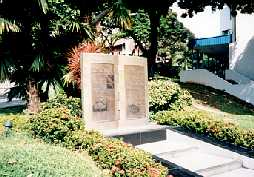 Site 8 の記念碑 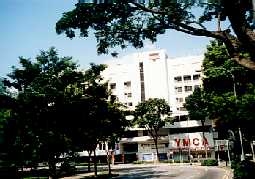 現在のYMCA (Orchard Rd.) |
The old YMCA Building which once stood here was the East Branch of the Kempeitai(Japanese Military Police). The much-feared Kempeitai was assigned to crush local resistance to Japanese rule. They conducted the "Sook Ching"(mass screening)Operation which resulted in the deaths of many Chinese suspected of being anti-Japanese. The Kempeitai recruited informers from within the local community thus sowing distruct among the population. People were taken away on mere suspection. Suspects were tortured during interrogation. The quiet of the building's surrounding was often broken by the screams of victims from within. Elizabeth Choy, one of those who survived imprisonment and torture by the Kempeitai, recalls "Idon't think hell could be worse than that". かつてここにあった旧YMCAビルに憲兵隊東支部が置かれた。 憲兵隊による「粛清」行動のなか、抗日活動の嫌疑を受けた大勢の華人が生命を落とした。 抗日容疑者たちは取り調べで拷問を受け、その悲鳴がビル周辺の静寂を破ることもしばしばであった。 |
|
[Site_9] . JAPANESE PROPAGANDA DEPARTMENT HEADQUARTERS (日本軍宣伝工作本部)
[Map] |
|
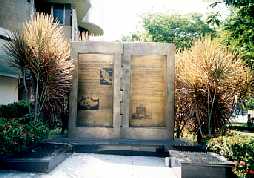 Site 9 の記念碑 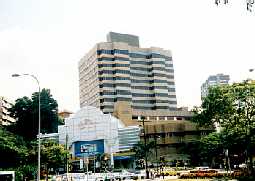 現在のキャセイ・ビル |
Cathay Building housed the British Malaya Broadcasting Corporation before the Japanese occupied Singapore. During the Occupation, the Japanese took over the building for their own propaganda activities. They tried to impose the Japanese language on the local population through their radio transmission from Cathay Building. Listening to Allied broadcasts was not allowed. Many refused to listen to the Japanese broadcasts and risked their lives by secretly tuning in to the British Broadcasting Corporation(BBC)for news. Cathay Building later served as headquarters for Admiral Louis Mountbatten, who accepted the Japanese surrender in 1945. 占領時、日本軍はキャセイ・ビルから軍政のプロパガンダ放送を行った。シンガポール人の多くはこの放送を嫌い、生命の危険をかえりみず、BBC(英国放送協会)のニュースに密かにダイヤルを合わせた。 のちにキャセイ・ビルは、1945年に日本軍の降状を受け入れたマウントバッテン将軍の司令部となった。 |
|
[Site_10] . BUKIT BATOK MEMORIAL (ブキバトの慰霊塔)
[Map] |
|
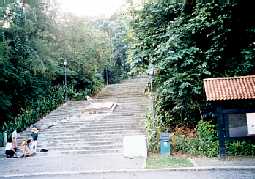 Site 10 の記念碑(階段の中央) 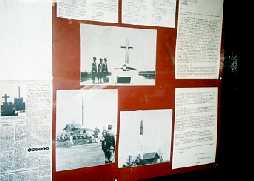 近くの掲示板には当時の写真も |
Two monuments once stood on top of this hill in memory of Allied and Japanese soldiers killed in the battle for Singapore. Built by some 500 Allied prisoners-of-war in 1942, the Japanese memorial, the Syonan Chureito, was a 40-foot high wooden pylon topped with a brass cone. To the rear was a small hut housing the ashed of Japanese soldiers killed in the Battle for Bukit Timah. The prisoners-of-war were allowed to build a second monument to honour the Allied dead. This was 10-foot high wooden cross which stood just behind the Japanese monument. The Syonan Chureito was destroyed by the Japanese before the return of the Allied Forces to Singapore in 1945. 1942年、日本軍は「昭南忠霊塔」の建立を連合国捕虜に命じた。日本軍戦死将兵を祭るこの慰霊塔は、先端を円錐状の銅で覆った高さ約12メートルの木造の塔であった。また捕虜らは、英軍連合部隊戦死将兵の霊を串う高さ約3メートルの木造の十字架を「昭南忠霊塔」のうしろに建てた。 「昭南忠霊塔」は1945年、連合軍がシンガポールに上陸する前に日本軍によって取り壊された。 |
|
[Site_11] . INDIAN NATIONAL ARMY MONUMENT (インド国民軍記念碑)
Map |
|
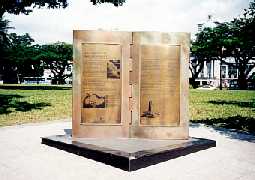 Site 11 の記念碑 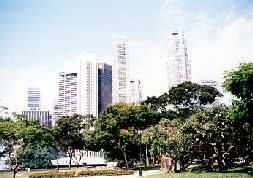 周辺の風景 |
In the final months of the Japanese Occupation of Singapore, a memorial dedicated to the "Unknown Warrior" of the Indian National Army(INA) was constructed at this site. The local INA was formed in 1942 with Japanese support. It sought to liberate India from the British and consisted mainly of prisoners-of war from the British Indian Army, Subhas Chandra Bose, who led the INA from 1943 onwards, laid a foundation stone at the monument in July 1945. The Urdu words inscribed on the monument read:ITTEFAQ(unity), ITMAD(faith) and KURBANI(sacrifice). When the British returned to Singapore, they demolished the memorial barely two months after its installation. インド国民軍(INA)の「無名戦士」に捧げる記念碑が1945年ここに建立された。INAは1942年、英国からインドを解放するため、日本軍の支援を受けてシンガポールで創設された。 この記念碑はシンガポールに帰還した英軍によって取り壊された。 |
|
関 連 記 念 碑 |
|
[関連_A] . KRANJI WAR CEMETERY 1939-1945 (クランジ戦没者記念碑)
[Map] |
|
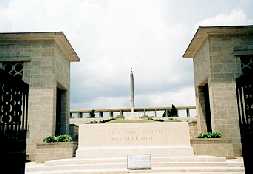 正面入口 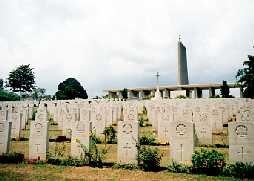 整然と並んだ墓碑 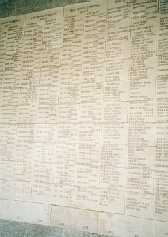 記念碑の壁には多くの犠牲者の名前が刻まれている |
On the walls of this memorial are recorded the names of twentyfour thousand soldiers and airmen of many races united in service to the british crown who gave their lives in malaya and neighbouring lands and seas and in the air over southern and eastern asia and the pacific but to whom the fortune of war denied the customary rites accorded to their comrades in death. They died for all free men. 第2次世界大戦時、シンガポール防衛のために犠牲になった約24000人のイギリス軍兵士のための墓地。 きれいに整備された墓地には、多くの墓碑が整然と並んでいる。 また、中央奥の慰霊碑の壁には、犠牲になった数多くの兵士の名前が刻まれている。 |
|
[関連_B] . SUN YAT SEN VILLA ( 「晩晴園」 −孫文記念館− )
[Map] |
|
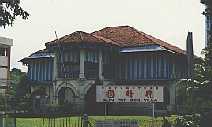 晩晴園 −孫文記念館− 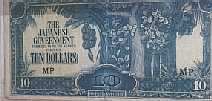 ”バナナ・マネー” |
孫文は、ここを中国同盟会南洋支部として活動の場にあてていた。1942年、日本軍に占領され、建物の一部、文献などが破損されたが、終戦後修復された。 この中には、孫文の写真、資料などとともに、昭南島時代(日本がシンガポールを占領したとき、シンガポールを”昭南島”と呼んでいた)の資料、その時使われていたお金、犠牲になった人たちの遺品なども陳列されている。 「日本占領時、通貨も日本によって変更させられた。その時のお金は、バナナの絵が描かれていたので、通称”バナナ・マネー”と呼ばれていた・・・。終戦後はそれらは単なる紙切れになった・・・。」という話を旅先で出会ったシンガポール人から聞いた。 |
|
[関連_C] . Memorial to the civilian victims of the Japanese Occupation 1942-1945 (日本占領時期死難人民記念碑)
[Map] |
|
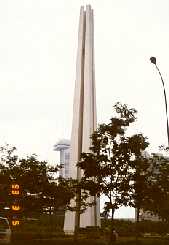 高さ68mの記念碑 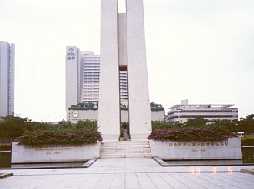 記念碑の正面 |
This memorial was erected by the people of Singapore though the efforts of the Chinese chamber of commerce and the assistance of the government from funds donated by the government and people of Singapore. It was unveiled on February 15, 1967, by The Prime minister In deep and lasting sorrow this memorial is dedicated in memory of those of our civilians who were killed between February 15, 1942 and August 18, 1945, when The Japanese Armed Forces Occupied Singapore. 昭南島時代(日本がシンガポールを占領したとき、シンガポールを”昭南島”と呼んでいた)、多くの現地の人たちが犠牲になった。その犠牲者の霊を慰めるため、そして再び同じことを繰り返さないとの願いをこめて、1967年にこの慰霊碑が建てられた。 この慰霊碑は4本の柱からなっており、これはシンガポールを構成している民族、つまり中国人、マレー人、インド人、ユーラシア人をあらわしている。 記念碑の正面には中国語(漢字)で「日本占領時期死難人民記念碑」と刻まれている。 日本がシンガポールを占領した日にあたる2月15日には、毎年ここで記念式典が開かれる。 |
|
[関連_D] . THE JAPANESE CEMETERY PARK (日本人墓地公園)
[Map] |
||
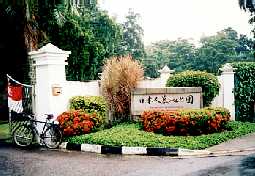 日本人墓地公園入口 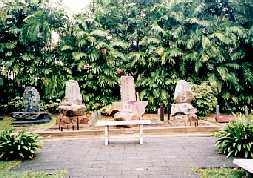 「戦没者の碑」 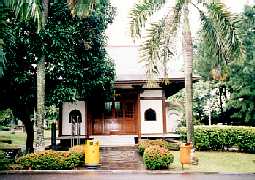 御堂 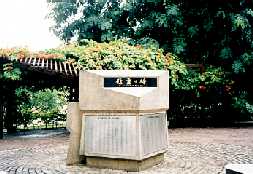 「慰霊の碑」  墓地公園内の光景 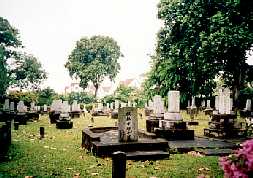 墓地公園内の光景 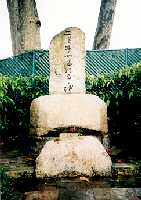 ロシア留学の帰途に亡くなった 二葉亭四迷 の墓石 |
遠く青ぐもを望み、翼を海の外に伸ばさんとするものら、ここに、装い新たなる七・二エーカーにおよぶ日本人墓地公園の落成と慰霊碑の建立を祝うことになった。一同この日を待つこと久しく、その感慨も、ひとしお深い。 この墓地公園は、シンガポール日本人会三十周年記念事業として、在住同胞、故国の意志、日系企業、日本政府のみならず、シンガポール人士らの心からの義捐により、また、この事業に関与された各位の二年有余にわたる献身により完遂をみたものであって、シンガポール日本人史上、誇るべく、かつ、大いなる足跡である。 その縁起をたずねると、遠く一八九一年(明治二十四年)二木多賀治郎が、この海外僻遠の地に雄図半ばに倒れた人たちの身上を憐れみ、自己所有のゴム林と隣接公有地を日本人専用墓地たらしむべく、同志ら相語らい、英国植民地政府に起請したときに遡る。 この墓地の管理は、当初、二木ら有志により、それ以降終戦までは、共済会、日本人会、湘南奉公会など、その時代の日本人組織により、取り行われた。 戦後は、敵産処分のまま、一九五三年(昭和二十八年)総領事館にゆだねられたが、一九五七年(昭和三十二年)同胞有志ら相計り、既に荒廃したこの墓地を自ら維持清掃することを約し、これを機に現日本人会の前身たる日本人クラブが発足した。 一九六九年(昭和四十四年)福田庫八ら四名の発起により、シンガポール政府に墓地の返還を請願し、正式に日本人会に還付された。 それ以降、日本人会は、鋭意その管理向上に努めたが、一世紀を経た墓地の老朽は甚だしく、通常の管理をもっては維持困難となった。因って、創立三十周年を期して、あまねく勧進を行い、有志ら力行して、この大改修を完遂したのである。 思うに、ここに眠る戦前の人たちの大半は、若年の夢と共に、この地に渡来した民間人で、その数は、既に朽ち果てた木標を含めると千に達する。 そして先の太平洋戦争は、この墓地の様相を一変する。戦犯刑死一三七柱を始め、戦没者の数は、優に万を超え、戦争の傷跡は痛ましい。 見残せる夢を抱いて眠るもの、戦争の非運に倒れて眠るもの、みな、その眠りの安らかんことを、ひたすら祈る。このいしぶみはその祈りのよすがたらんことを、希うものである。 星は移り、人は去ってゆく。ここ墓地公園には、明治、大正、昭和の重要な日本の海外史が眠っている。 南国の空、緑蔭のもと、ゆっくりと歩を進め、過去に向って問いかけるならば、過去との対話は、その尽きるところを知らないであろう。 更に、ここは、人びとが明日の平和と国際友誼を実践するための、語り合いの場として、末永くその使命を果たすであろう。 一九八七年 七月 シンガポール日本人会 墓地管理委員会 五十嵐 斌 , 安川 一夫(碑文撰者) , 大崎 辰次郎 , 鶴原 宏 , 古川 和夫 , 杉野 一夫 , 今村 由美(事務局) |
|
| 参 照 資 料 |
| "World War II Sites of Singapore" (英文資料) |
| "地球の歩き方 シンガポール編" (ガイドブック) |
| "ISLAND & CITY MAP OF SINGAPORE" (地図) (シンガポール全土のほとんどの通りの名前が載っている地図) (シンガポールそごう[ラッフルズ・シティ内] 3F 紀伊国屋書店で購入。S$14.95 ) |
| ご 協 力 |
| Singapore Tourism Board (シンガポール政府観光局) |
| そ の 他 |
| 各記念碑には、1999/Aug/13-14 に自転車で探してまわりました。(暑かった…。) |